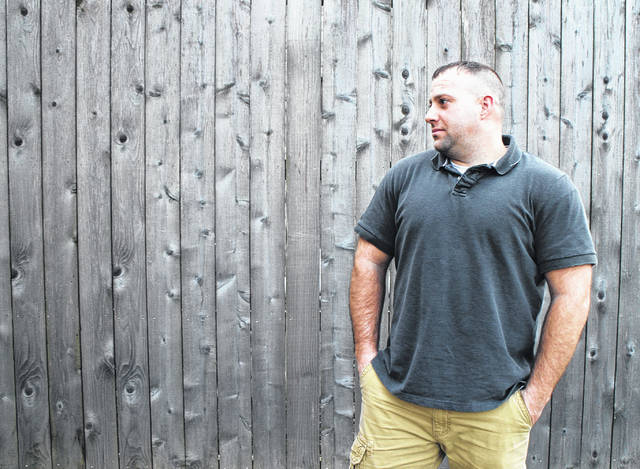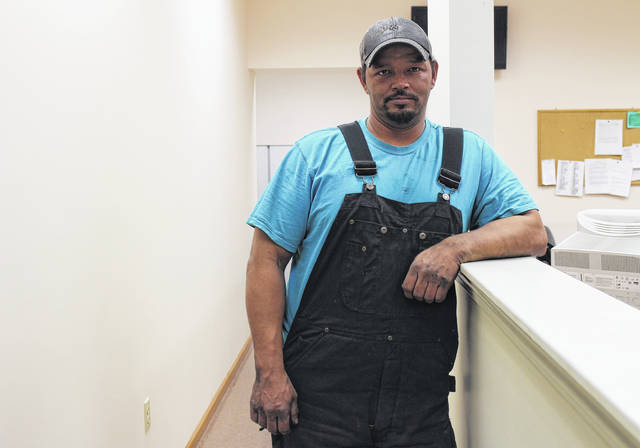


Editor’s note: The following is the second of a three-part series, leading into sustained coverage throughout the year, by The Times-Gazette and the AIM Media Network delving into the impact the opioid epidemic has had on Highland County, across Ohio and the rest of the country.
Jason Snider and Nathan Burns have a couple of things in common. Both are family men, both grew up in the area, both say their faith in God got them where they are today, and both have struggled with drug addiction.
And, like many around the country, both began their fight with substance abuse safely and legally with prescription medication.
For Snider, it started when a semi truck struck his car and put him in a coma at 20 years old.
Snider grew up in Lynchburg, and was no stranger to substance abuse as kid. His parents worked third shift, and he was often left to fend for himself.
He tried marijuana for the first time as early as 14, but that was hardly addiction. He still had plenty of friends, did fine in school and was phenomenal at sports, particularly baseball.
It was another four years before the accident happened.
“That’s when I got hooked on them Percs,” he said, referring to Percocet. Then came cocaine, then came methamphetamine, then came heroin.
“I tried every drug there was,” he said. “Got in with some bikers when I was 21, 22, got into the meth game. I learned how to make it and distributed it in our county and every other county I could get into.”
Snider said he consistently consumed about five grams of methamphetamine and as much as a gram of heroin per day, and sold or traded whatever other drugs he could get his hands on.
“I’m lucky I’m alive,” he said.
He hit rock bottom not too long after he missed his uncle’s funeral.
With warrants out for his arrest, he stole a truck and went on the run. When he finally got caught, he might as well have turned himself in.
“I didn’t want to kill myself, but I didn’t care if I died,” he said. “Once they finally arrested me the last time, I was willing to do whatever it took to change my life around… I told them on the way, ‘I need help or I’m gonna die.’”
For Burns, it started when he busted his kneecap at work.
Burns was 30 when he was injured, and prior to that, he had never used any kind of drugs.
His prescription was for Vicodin at first, then Percocet.
“That’s when it escalated,” Burns said.
The prescriptions continued for three years, and then, “They just cut me off. Said I didn’t need ‘em no more. That’s when all the doctor shopping and stuff was going on.”
For a while, he got them off the street. Then they got hard to find. That’s when he was introduced to heroin — and it was incredible.
“When I tried it for the first time, the room lit up,” he said.
Over the next four years, Burns evaded the law and quietly continued his habit.
“It was miserable,” he said. “Not having money, worrying about where you was going to get your next one from, the lying, the conniving you do to your family and stuff.”
Neither Burns nor Snider overdosed, although Snider said there were a few times when he got so high he would wake up with no idea where he was or how long he was out.
Burns said he’s lost a number of acquaintances to overdoses, and even saw one happen.
“When you hear it, it’s just like, well, that person overdosed,” he said. “But when you see it with your own eyes, it’s completely different… just nodding off into a trance, turning blue, unresponsive… It’s scary.”
Burns finally got caught during a trip home from Tennessee for Thanksgiving in 2016. He had lived there for two years, and was on probation here the whole time.
Burns noted that heroin and opioids were practically non-existent in Tennessee, although substance abuse was clearly common.
“It had been so rough, back and forth over the years, and I really wanted to quit, I really did,” he said. “I was sick and tired of not having nothing, not being able to work because I was dependant on it. I was ready to be done.”
Both Burns and Snider did stints in jail before getting treatment — but first came detox.
Burns shook his head as he explained the symptoms.
“Miserable,” he said. “Anywhere from seven to 14 days, throwing up, hot flashes, restless.”
Snider was accepted at a treatment program in Lebanon, and Burns started a medically assisted treatment program available through Hillsboro Municipal Court.
Now, Burns’ relationship with his family is restored and he’s back to driving trucks.
He has been clean for more than a year.
Snider has been clean for nearly seven years. He has married his high school sweetheart and fathered five children, and a sixth is expected to arrive near the seven-year marker of his recovered life.
Although Burns and Snider are living clean now, thousands around Ohio and millions around America are still dependent on prescription medications.
According to the Centers for Disease Control, nearly two million Americans abused or were dependent on prescription opioid medications in 2014, and as many as one in four people who take prescription opioids long-term for pain not related to cancer struggles with addiction.
While the United States represents about five percent of the world’s population, it consumes 80 percent of the world’s opiates.
Snider said on Wednesday he wants to help turn the tide, at least in Highland County.
He currently serves as a member of the Highland County Drug Abuse Coalition and a co-chair of Hope for Highland County, both local alliances that organize initiatives and events to curb drug abuse here.
Snider said Alcoholics Anonymous and Narcotics Anonymous meetings are held every week in Highland County, and at the very least, that’s a place to start.
“Anybody struggling who wants to reach out, there are a lot of people in this county who are here to help,” Snider said. “We’ll go out of our way to help.”
Burns said he hopes his story will help somebody realize life is better when you’re clean.
“They don’t want to hear about recovery because the opioids are still thinking for them,” he said. “If they do decide to get clean, it’ll be the best thing that ever happened to them. That’s about all I can tell you.”
Reach David Wright at 937-402-2570, or on Twitter @DavidWrighter.




